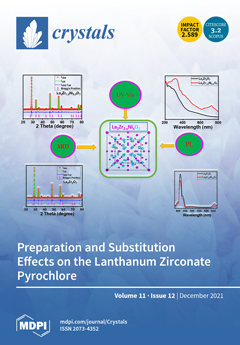The crystal structure, mechanical anisotropy, elastic properties and electronic characteristics, as well as the stability, of
P4/
m BN are predicted by means of density functional theory. In this work, BN in the
P4/
m phase demonstrates mechanical and dynamical stability.
[...] Read more.
The crystal structure, mechanical anisotropy, elastic properties and electronic characteristics, as well as the stability, of
P4/
m BN are predicted by means of density functional theory. In this work, BN in the
P4/
m phase demonstrates mechanical and dynamical stability. Compared with the values of bulk
B,
E and
G in the
P4/
m phase, the
B of BN in the
P4/
m phase is greater than that of dz4 BN, while the
G and
E of
P4/
m BN are greater than those of
Pnc2 BN and dz4 BN. The ratio of the bulk-to-shear modulus for
P4/
m BN is less than 1.75 and dz4 BN, dz2 BN and lzlz2 BN, indicating that
P4/
m BN is more brittle than dz4 BN, dz2 BN and lzlz2 BN.
P4/
m BN exhibits stronger mechanical anisotropy in
G and
E than
Pbca BN,
P4
2/
mnm BN and
Pm-3
m BN but much weaker mechanical anisotropy than
P4/
mbm BN, B
7N
7, B
11N
11 and B
15N
15. In addition,
P4/
m BN is a quasi-direct bandgap semiconductor, and the difference between the direct and the indirect bandgap is 0.008 eV. In order to obtain further characteristics of
P4/
m BN for future synthetic verification, the
X-ray diffraction (XRD) patterns for
P4/
m BN are also calculated. Given its properties,
P4/
m BN is a good candidate for photoelectric devices.
Full article





